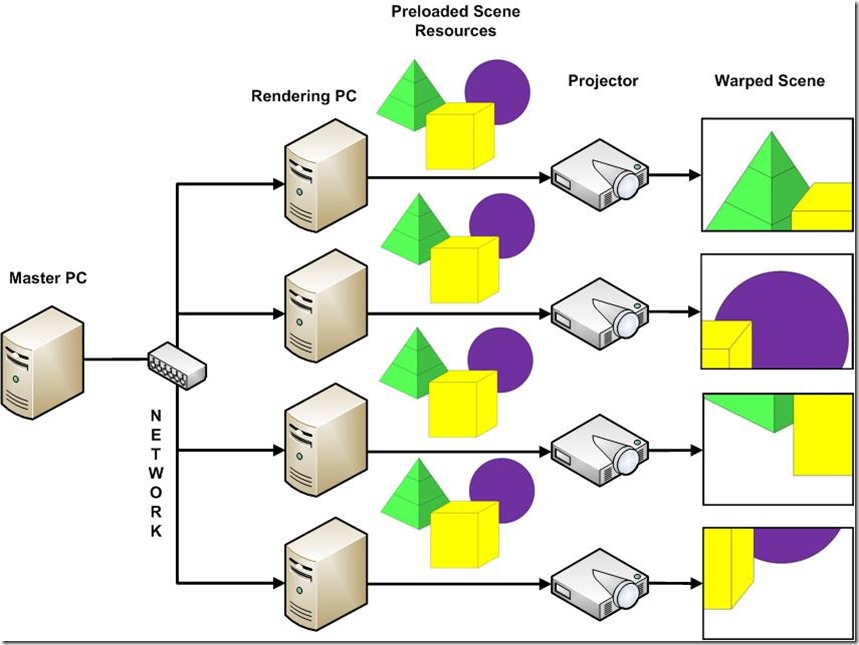Multi-Projector Based Display Code ------- Home
Overview
This project provides you with the tools and techniques you need to create your own large-area multi-projector display that is both affordable and flexible. It covers the procedure you need to take and the issues you need to consider for achieving geometric alignment and color seamlessness, and an image rendering system using PC clusters. It also provides the necessary codes of a simple distributed calibration and image/3D-model rendering display system.
Who should use this code
- Novice who would like to build their own camera-projector display system can use this code as a start point
- Researchers who are interested in camera-projector display system can use this code as a reference
System Architecture
With the recent popularization of low-cost commodity graphics cards, it is possible to build a distributed rendering system with a cluster of PCs. The following figure shows the architecture of our PC-cluster based multi-projector display:

Figure 1. The system architecture of our PC-Cluster based multi-projector display
As you can see from the above picture, the system consist of one master PC and a few rendering PCs. Each rendering PC is connected to one projector. All the PCs are connected via a local network. The master PC controls the rendering procedure of the system, and the rendering PCs do the actual rendering work and output through the projectors. The overall goal is to make the casually placed projectors behave like a large integrated display when showing images and other scenes.
The scene resources are preloaded to the rendering PCs and each PC will only show its own portion according to prior calibration, as shown in the figure. Because the projectors are casually placed, the scene from different projectors may not be well aligned, and the overlapped area of two or more projectors may looks brighter than other area. So the rendering PCs need to warp the scene to achieve geometry alignment and color seamlessness. The basic procedure of the PC-Cluster based display system involves two steps: the camera-based calibration step and the scene warping step. During the calibration step, special featured images are projected and corresponding camera images are grabbed. After analysis of the grabbed images, geometry information about how to warp the scene and alpha mask about how to achieve photometric alignment will be atomatically generate. During the scene warping step, each projector will warp the scene resources according to the calibration result.
You can find more information about geometry alignment from Chapter 3 of reference [1], about color seamlessness from Chapter 4 of reference [1], about PC-Cluster rendering from Chapter 5 of reference [1]. You are strongly recommended to read the book thoroughly before starting to set up your own multi-projector display.
Hardware and Software Requirements
In order to use the codes provided, you need to meet the following hardware and software requirements:
Hardware requirements:
- One PC with monitors, as master PC;
- Two or more PCs with dedicated graphic cards (we use NVIDIA GeForce 8800GTS), as rendering PC;
- Two or more projectors (one for each rendering PC);
- One hub or router and network cables;
- One OpenCV-compatible camera with proper lens (see FAQ for more information about how to select camera and lens);
Software requirements:
- Windows XP installed on all PCs;
(Below are the additional software you need to install if you want to compile the source codes yourself)
- Microsoft Visual Studio 2005 or above;
- OpenCV library 1.0 (from reference [2]) installed;
- GLUT library 3.7 (from reference [3]) installed;
- FreeImage Algorithms (from reference [4]) installed;
[1] "Practical Multi-Projector Display Design", Majumder/Brown, AK Peters, USA, 2007
[2] Open Computer Vision Library, 1.0:http://sourceforge.net/projects/opencvlibrary/
[3] GLUT - The OpenGL Utility Toolkit, 3.7: http://www.opengl.org/resources/libraries/glut/
[4] FreeImage Algorithms Library: https://code.launchpad.net/~glennpierce/+junk/main
View this page in Romanian courtesy ofazoft
Multi-Projector Based Display Code ------- Home的更多相关文章
- Multi-Projector Based Display Code ---- ImageViewer
Overview Image viewer is a typical application for large display. It makes use of the high-resolutio ...
- Multi-Projector Based Display Code ---- FAQ
Frequently Asked Question How do I know that my camera has a proper lens? Answer: If you can see exa ...
- Multi-Projector Based Display Code ---- Calibration
Overview As mentioned previously, there are two main steps in generating a seamless display. The fir ...
- Multi-Projector Based Display Code ---- ModelViewer
Overview Model viewer is another application we provided for large display. It is designed for viewi ...
- Multi-Projector Based Display Code ---- Download
The code providing are for your reference. Please download the code according to your hareware confi ...
- Peer Code Reviews Made Easy with Eclipse Plug-In
欢迎关注我的社交账号: 博客园地址: http://www.cnblogs.com/jiangxinnju/p/4781259.html GitHub地址: https://github.com/ji ...
- Code Pages
https://docs.microsoft.com/en-us/windows/desktop/intl/code-pages Most applications written today han ...
- 设备管理 USB ID
发现个USB ID站点,对于做设备管理识别的小伙伴特别实用 http://www.linux-usb.org/usb.ids 附录: # # List of USB ID's # # Maintain ...
- Oracle Database 11g express edition
commands : show sys connect sys as sysdba or connect system as sysdba logout or disc clear screen or ...
随机推荐
- IIS短文件漏洞(搬运整理)
0x01. IIS短文件漏洞的由来 Microsoft IIS 短文件/文件夹名称信息泄漏最开始由Vulnerability Research Team(漏洞研究团队)的Soroush Dalili在 ...
- Junit的基础学习
一个强大的单元测试框架: 一.组成部分: 1.注解: (1)@Test 注解: 放在测试方法上,表示这是用于测试其他方法的一个测试单元 @Test public void testSum1(){ Sy ...
- linux文件系统初始化过程(4)---加载initrd(中)
一.目的 上文详细介绍了CPIO格式的initrd文件,本文从源代码角度分析加载并解析initrd文件的过程. initrd文件和linux内核一般存储在磁盘空间中,在系统启动阶段由bootload负 ...
- AUTOCAD参数约束功能
概要:http://through-the-interface.typepad.com/through_the_interface/2011/08/a-simplified-net-api-for-a ...
- linux网关下drcom web自动登陆脚本
/etc/init.d/drcomd: #!/bin/sh # # The environment is cleared before executing this script # so the p ...
- 面试容易问到的Linux问题
1.有没有使用过linux?用来干什么? Linux是一个长时间运行比较稳定的操作系统,我们一般会拿它作为服务器. 一下软件(redis等)没有软件包,需要在linux的C编译环境下编译得到软件包. ...
- Excel 恢复默认行高、列宽
操作系统:Windows 10 x64 工具1:Excel 乱糟糟的! 选中需要调整的区域,选择菜单:开始 > 格式 > 自动调整行高 选中需要调整的区域,选择菜单:开始 > 格式 ...
- Python调用selenium
import time from selenium import webdriver from selenium.webdriver.common.touch_actions import Touch ...
- #Node.js的fs导入遇到的问题和解决方案
一直在使用VS Code,今天打算用Node.js进行文件IO时候遇到了一些问题,fs是Node.js的核心功能之一,一开始我用Javascript编写fs模块的导入. var fs = requir ...
- tensorflow建造神经网络-【老鱼学tensorflow】
上次我们添加了一个add_layer函数,这次就要创建一个神经网络来预测/拟合相应的数据. 下面我们先来创建一下虚拟的数据,这个数据为二次曲线数据,但同时增加了一些噪点,其图像为: 相应的创建这些伪造 ...
